Mailbag: Why are the Jets looking like Cup contenders?
Advertisement
Read this article for free:
or
Already have an account? Log in here »
To continue reading, please subscribe:
Monthly Digital Subscription
$0 for the first 4 weeks*
- Enjoy unlimited reading on winnipegfreepress.com
- Read the E-Edition, our digital replica newspaper
- Access News Break, our award-winning app
- Play interactive puzzles
*No charge for 4 weeks then price increases to the regular rate of $19.95 plus GST every four weeks. Offer available to new and qualified returning subscribers only. Cancel any time.
Monthly Digital Subscription
$4.99/week*
- Enjoy unlimited reading on winnipegfreepress.com
- Read the E-Edition, our digital replica newspaper
- Access News Break, our award-winning app
- Play interactive puzzles
*Billed as $19.95 plus GST every four weeks. Cancel any time.
To continue reading, please subscribe:
Add Free Press access to your Brandon Sun subscription for only an additional
$1 for the first 4 weeks*
*Your next subscription payment will increase by $1.00 and you will be charged $16.99 plus GST for four weeks. After four weeks, your payment will increase to $23.99 plus GST every four weeks.
Read unlimited articles for free today:
or
Already have an account? Log in here »
Hey there, time traveller!
This article was published 24/11/2024 (413 days ago), so information in it may no longer be current.
ST. PAUL — The Stanley Cup playoffs are still five months away, but you can’t blame Winnipeg Jets fans for already thinking about what the spring might bring.
A sizzling start to the season has them looking like a legitimate championship contender even if there are still miles to go before they sleep.
Still, it’s no surprise that our monthly mailbag was filled with questions looking ahead to what the club needs to do to reach its ultimate goal.
Free Press hockey writers Ken Wiebe and Mike McIntyre weigh in with their answers on that and other subjects:
1. At the first-quarter mark of the season, what are the key reasons for Winnipeg’s early season success? ED
WIEBE: This list is a lengthy one and the entire league has taken notice. First and foremost, the Jets haven’t strayed from the structure that helped them capture the Jennings Trophy for allowing the fewest goals in the NHL last season. In fact, it’s becoming second nature for them and having that as a foundation has allowed the Jets to increase their offensive production without actually cheating for it.
GENE J. PUSKAR / THE ASSOCIATED PRESS FILES Winnipeg goaltender Connor Hellebuyck begins to celebrate a win as time runs out in an NHL game against the Pittsburgh Penguins on Friday.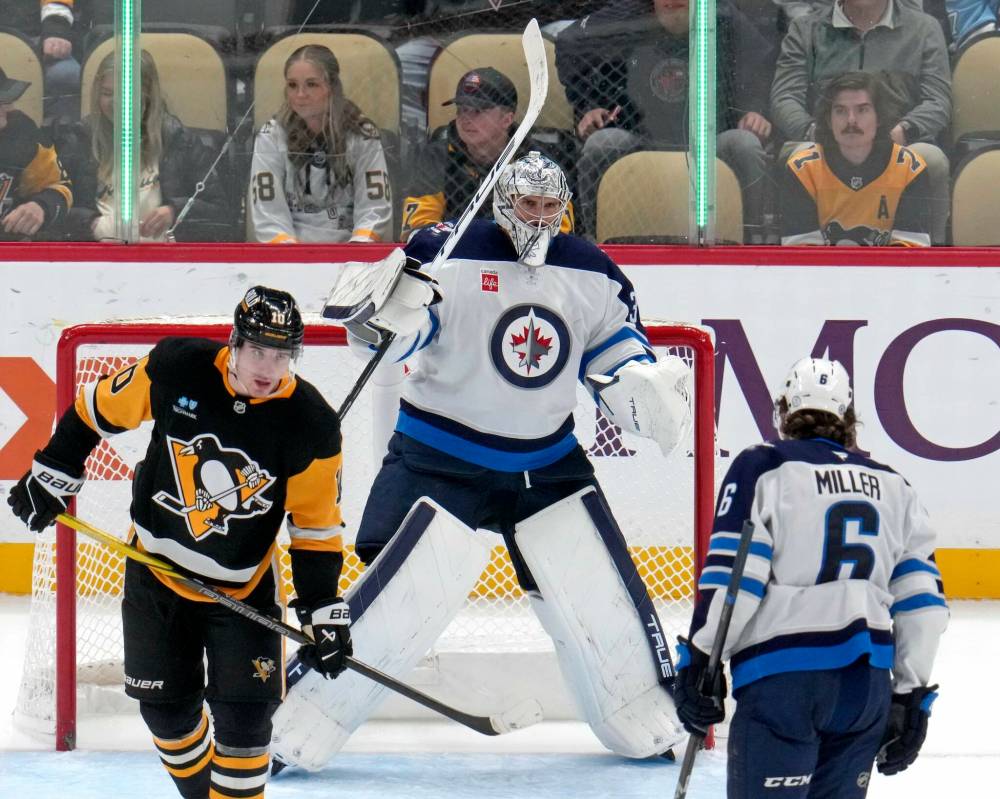
Former Jets head coach Rick Bowness was adamant his team would have won the Presidents’ Trophy last season with even average special teams and lo and behold, the Jets lead the league in power-play efficiency and have moved from the bottom third to the middle third on the penalty kill.
The Jets’ depth up front continues to shine and the star players are off to an exceptional start.
Jets goalie Connor Hellebuyck currently boasts a record of 14-2, a goals-against average of 2.13 and a save percentage of .924. He’s been awesome, though the Jets haven’t been nearly as reliant on him as in season’s past. The Jets went 9-1 and 8-2 in their first two 10-game segments and having an excellent record within the Central Division has also been an important element of the early-season success.
MIKAELA MACKENZIE / FREE PRESS FILES Winnipeg Jets head coach Rick Bowness announces his retirement at the Canada Life Centre on Monday, May 6.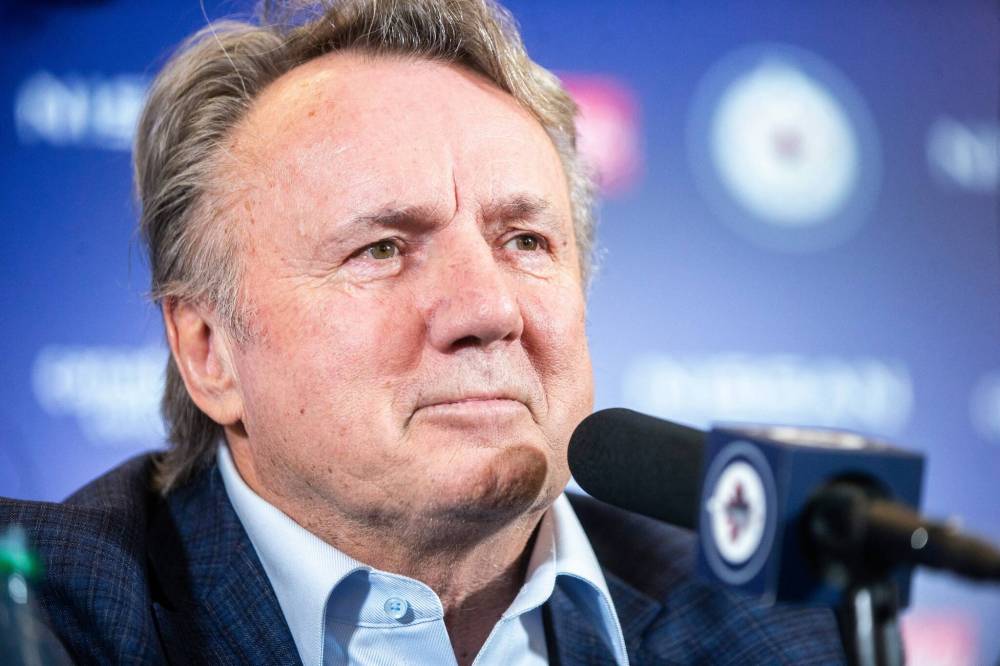
2. What specifically did Coach Bones do with the club to see that big bump in results? Better defensive play, tighter gaps, working together as a group? Did Scott Arniel add something to it? (PP and PK aside). CHRIS
MCINTYRE: You’ve certainly identified many of the key fundamentals, with an emphasis on tightening up things in their own end a top priority. More than anything, Rick Bowness, and now Arniel, have shown this group that good defence really can lead to more offence.
To the credit of the players, they’ve (finally) bought what their coaches have been selling, and the proof is in the pudding. Coaching is as much about relationship-building as it is Xs and Os — maybe even more so, quite honestly — and you have to tip your cap to how Bowness was able to start repairing major cracks in the foundation of how this team played.
GENE J. PUSKAR / THE ASSOCIATED PRESS FILES Winnieg Jets head coach Scott Arniel (centre) stands behind his bench during the second period of an NHL game against the Pittsburgh Penguins on Friday in Pittsburgh.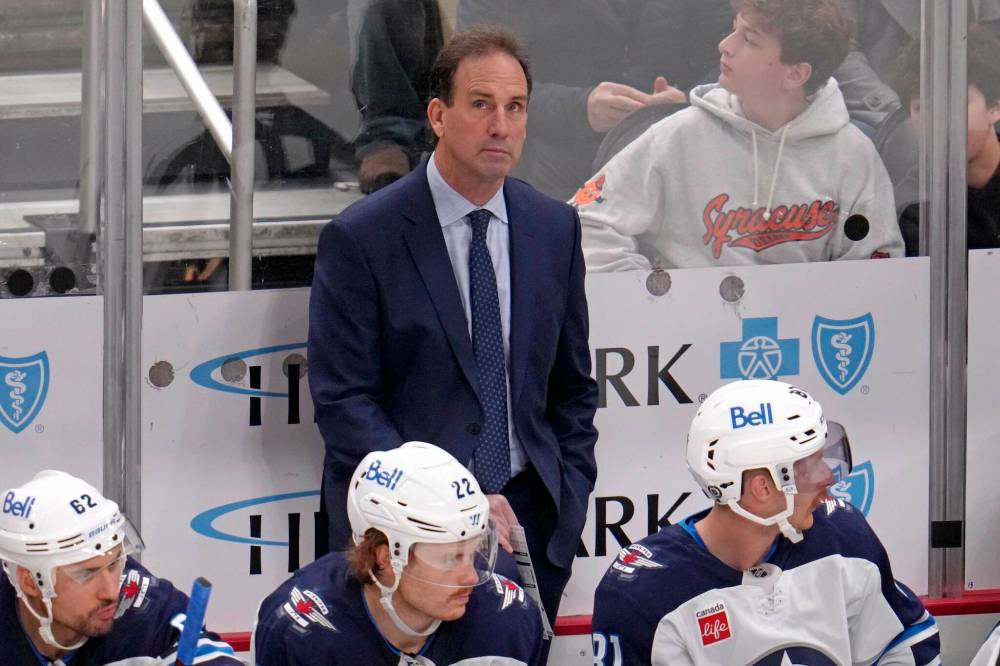
Arniel has stepped in and not missed a beat, either. But it ultimately comes down to giving the players the information and the tools they need, then putting them in a position to succeed.
And what we are now seeing is a core group that, as Arniel likes to say, has developed some calluses as a result of previous playoff disappointments and has doubled down this year on its commitment to solid structure. Even though it’s largely the same group of players, you can’t help but notice how much faster they seem to play. That’s also about pace and tempo, which Bowness and now Arniel have repeatedly preached. It’s a lot of fun to watch, unless you are one of Winnipeg’s opponents these days.
3. Where are the predicted wild-card Jets and what have you done with them? Not that I’m complaining. SHELDON
WIEBE: Whether it’s in this space in our monthly mailbags or our predictions for the paper, my prediction was that the Jets would be among the top three teams in the Central Division and not just a wild-card team. Plenty of other pundits viewed the Jets as a wild-card club (or worse).
The prediction game can be a tough racket and sometimes it’s virtually impossible to tell how off-season changes are going to work out — see the Nashville Predators, who were expected to take a significant step forward after adding all of Steven Stamkos, Jonathan Marchessault and Brady Skjei in free agency and retaining defenceman Alexandre Carrier, who was drawing interest before deciding to stick around. That none of Marchessault’s 10 points have come during five-on-five play is a serious head-scratcher.
Back to the question at hand, it’s clear the Jets went home during the off-season with a serious sense of purpose. The core group isn’t happy about consecutive early exits and they put in the work to ensure those 10 per cent gains that were a prominent talking point on exit interview day were going to eventually come to fruition.
Through the first quarter of the season, not only do the Jets lead the Central Division, they also lead the Western Conference and have accumulated the most points in the entire league.
It’s been an impressive start, but now it’s up to the Jets to continue to show improvement as things get tougher and the intensity ratchets up.
FRED GREENSLADE / THE CANADIAN PRESS FILES Winnipeg’S Mark Scheifele (55) and Kyle Connor (81) celebrate Scheifele’s hat-trick on Florida Panthers goaltender Sergei Bobrovsky (72) during third-period NHL action on Nov. 19.
4. How much of this historic start comes from players like Mark Scheifele, Kyle Connor, Cole Perfetti, Neal Pionk, etc. looking internally and deciding to make fundamental changes to the way they play the game? How much comes from the group dynamics and how specifically do they hold each other accountable? How does this work? Are they confronting each other? Is there much discussion at this point about the way they want to play or do the players fully understand and accept their roles and responsibilities? What role does clarity around each player’s understanding of what they need to bring night in and night out and what they should NOT do and is NOT their responsibility as it falls outside their core strengths. CARL
MCINTYRE: These are terrific questions, Carl, and I think you’ve really hit on the crux of why this is working so well. Not to take any credit away from management or coaches, but it really boils down to the players at the end of the day. And this is a group that, quite frankly, was humbled and embarrassed at crashing out of the playoffs so quickly last spring.
They said as much publicly, and no doubt were even more vocal about it behind closed doors. Talk is ultimately cheap, but they’ve come out and “walked the walk” so to speak with their play. The bar has been raised internally and this really appears to be a cohesive group that is all pulling together in the right direction, led by their leaders. When you see the likes of Scheifele and Connor dropping the gloves to fight, that’s a sign of a complete buy-in.
5. What do the Jets need in order to prevent another first-round collapse? I don’t know how Chevy can pull it off, but I believe they need a top-pairing, big, fast, puck-moving, right-handed defenceman. @Oaktree65472824
6. What position do you think the Jets should bolster to help move them into a deep playoff run? @CanadianKen
7. If it’s not broke don’t fix it, but do the Jets still need to upgrade their defence and second-line centre positions? @204Joey
WIEBE: Every team in the NHL would like to add a big, fast, puck-moving defenceman for its top pairing. The player you describe sounds like Colton Parayko of the St. Louis Blues, but he has a no-movement clause and five seasons left on his contract (after this one) that carries an AAV of US$6.5 million.
The Blues are battling for a playoff spot and Parayko’s high level of play has him under consideration for Team Canada at the 4-Nations Face-Off, so he’s probably not going to be available anyway. As of this moment, the Jets have $3.433 million in cap space and project to have north of US$11 million in room available at the trade deadline according to Puck Pedia, so there would be room available to take a big swing.
JEFF LE / THE ASSOCIATED PRESS FILES Blues defenceman Colton Parayko (right) gets physical with Minnesota Wild right-winger Ryan Hartman on Tuesday, Nov. 19.
History has shown the Jets haven’t been afraid to add at the deadline during the years where they’ve been near the top of the standings — but many of those moves have been related to the second-line centre position. Might the strategy shift more to the blue line this February or March? Only time will tell, but it wouldn’t be a stretch to suggest it. But it’s important to remember that not many No. 2 D-men are available on the trade market and the ones who are usually come at an enormous acquisition cost.
There’s plenty of time before deadline deals move to the front burner, so let’s shift to the original query. What the Jets need to do to prevent another first-round exit is continue to be committed to the structure that’s made them successful for the majority of each of the past 100-plus games in the regular season.
The Jets have elite-level goaltending, excellent depth and their willingness to defend in all three zones has bolstered the offensive attack. Successful special teams play would augment all of those things. Winning a playoff series requires a lot of things going well for any team, let alone winning four rounds and 16 games. Look back to the last Jets’ series win for further proof.
Even in sweeping the Edmonton Oilers in the opening round of the Canadian (North) Division, the Jets required three consecutive overtime goals to do so, including a triple OT clincher from Kyle Connor. Stars need to shine, complementary players must step up and goaltending must be excellent for the Jets to try and advance past the opening round — and beyond.
MCINTYRE: The million-dollar question. Or, in the case of the Jets, multiple millions — as in, the accrued cap space they should have by the trade deadline next March to try and load up. One thing is clear: Kevin Cheveldayoff isn’t afraid to make a big splash.
Whether it was Paul Stastny in 2018, Nino Niederreiter and Vlad Namestnikov in 2023, or Sean Monahan and Tyler Toffoli in 2024, Cheveldayoff likes to reward his group when he thinks they have a chance to do some damage. So what might this year bring?
A big, strong, physical defenceman would be a target. How about Jamie Oleksiak of the Seattle Kraken? I think the recent games against Tampa Bay and Florida showed that the Jets might be a bit on the light side on the back end, especially against heavy opponents.
And in planning for what they hope will be a lengthy, four round playoff run, some size (that also has some skill) should be on the shopping list. You can never have enough depth, so another forward who could play up or down the lineup would make some sense as well. Whether that would be to knock someone like Namestnikov or Cole Perfetti off the second line remains to be seen.
LYNNE SLADKY / THE ASSOCIATED PRESS FILES Jets left-winger Nikolaj Ehlers (27) passes the puck as Florida Panthers defenseman Aaron Ekblad (5) defends during the first period on Nov. 16 in Sunrise, Fla.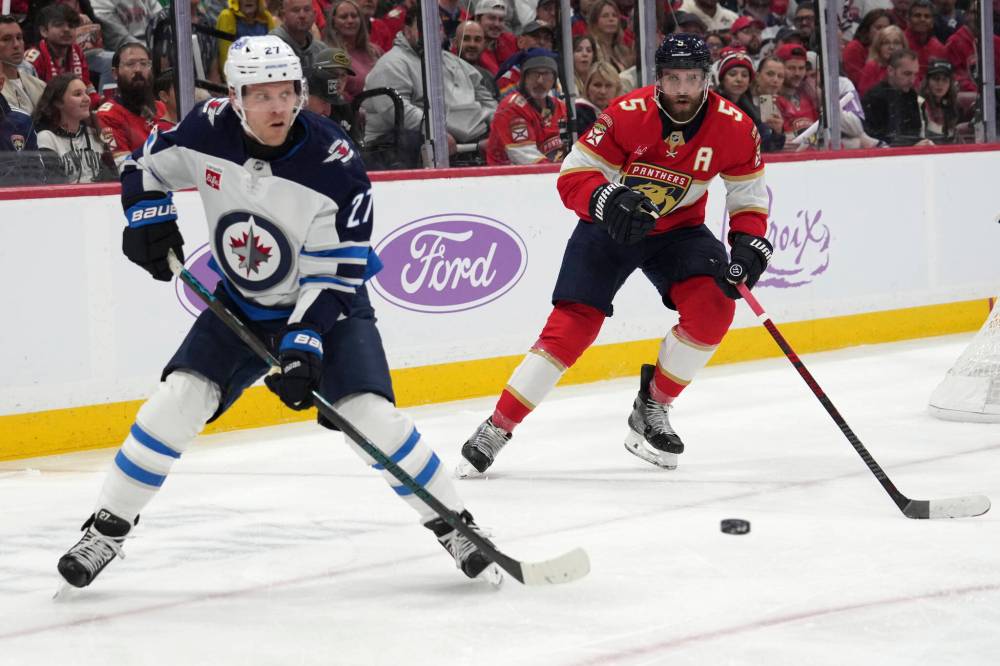
8. What were the chances that Nikolaj Ehlers would have re-signed here before this season, and what are the chances now that he’s being properly used this season? @WinnipegFirst
WIEBE: I will tackle the second question first. The topic of Ehlers and his usage has been a source of discussion and debate for years around these parts and will continue to be long after he signs his next contract, whether that’s here or elsewhere. Given Ehlers’ strong start, the noise surrounding him hasn’t been nearly as loud.
His promotion to the top power-play unit has been an important development and he’s flourishing in the pop position. After going a full season without recording a single power play marker and chipping in with seven assists (while being used mostly on the second unit and getting limited time), Ehlers already has three goals and four assists with the man-advantage this season (will update after Saturday’s game) with three-quarters of the season left to play. As for the issue of ice time, Ehlers is basically averaging the same amount as last season.
Ehlers is easily on pace for the most productive campaign of his career (his previous highs are 29 goals, 39 assists and 64 points). He’s well on his way to earning a raise from the US$6 million AAV he’s currently making as he finishes up the seven-year deal he signed on Oct. 4 of 2017 and kicked in the following season. As for the chances of Ehlers re-signing during the off-season, those were always going to be low, given the aforementioned concerns about usage.
Ehlers needed to see how the coaching change was going to impact his role before making any long-term commitments. Ehlers hasn’t wanted to discuss his future publicly and it seems doubtful that’s going to change. That doesn’t mean he isn’t open to an extension, but it’s likely he’s going to wait it out and see how the situation plays out.
When a player is this close to unrestricted free agency for the first time in his career, often there is a curiosity to find out what he might be worth on the open market.
9. Sometimes there seems to be no apparent reason for a player to be thrown out of the faceoff circle. No movement, no cheating lining up. Why? Any knowledgeable reasons for that happening? I may be the only Canadian-born male never to play hockey and I’ve always been curious. BOB
MCINTYRE: A timely question Bob, considering what went down Friday in Pittsburgh. Incredibly, every Jets forward except Kyle Connor took at least one draw. I don’t think I’ve ever seen that before.
A big reason was the linesmen appeared to believe the fans were there to see them, waving players out left and right all night long. The home team is supposed to have an advantage, with the visiting team forced to put their stick down first in the dot. But, to your point, it’s hard to discern exactly what the foul is when someone is tossed.
JEFFREY T. BARNES / THE ASSOCIATED PRESS FILES Buffalo Sabres centre Dylan Cozens (24) and St. Louis Blues centre Brayden Schenn (10) battle for the puck after a faceoff during an NHL game on Nov. 14 in Buffalo, N.Y. 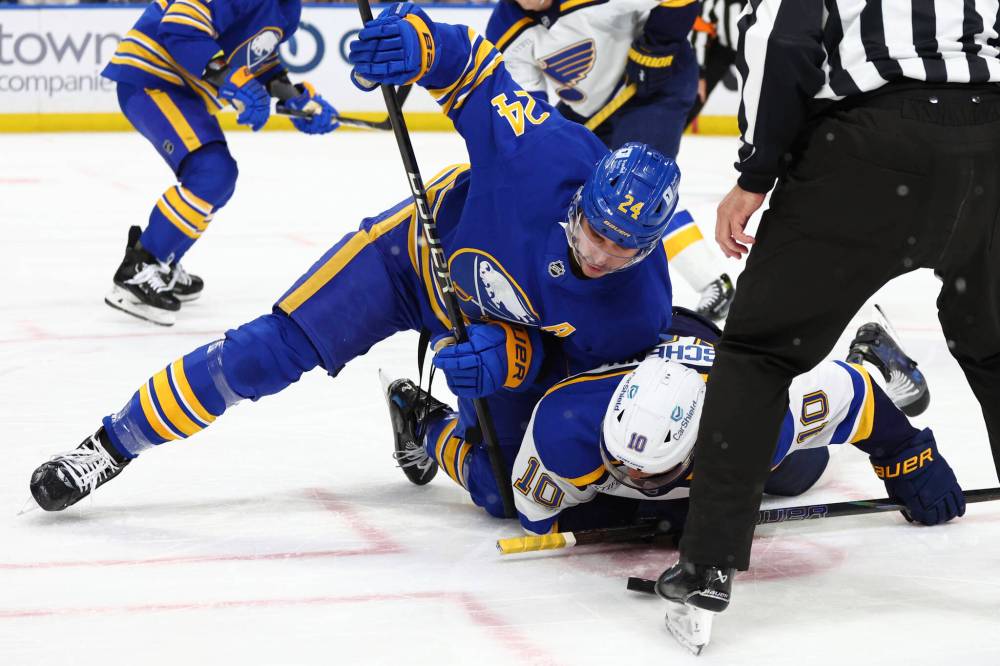
According to the NHL, these are the rules: 1. Players taking the face-off must have their shoulders square to their opponent; 2. The players taking the face-off will be approximately one stick-length apart; 3. The toe of the player’s stick blade must be set flat on the ice; 4. All other players participating in the face-off (such as wingers) must be at least 15 feet away from the players taking the draw.
Per the league, any violations of the above are grounds for dismissal, with a second violation on the same draw leading to a delay of game penalty (which you almost never see). The old saying “if you’re not cheating, you’re not trying” comes to mind, but it does seem lately like more enforcement than ever is happening. Presumably, the men in stripes see something amiss, even if it’s not always apparent. Just drop the damn puck, I say!
10. Scott Arniel’s pre-season proactive and public support for Nikolaj Ehlers has led to improved usage and performance. Do you anticipate that his recent public support for Ville Heinola will lead to Heinola being a permanent fixture in the top-6 D-men? How about PP2? Craig
WIEBE: Arniel has been transparent on multiple subjects since he took the job and his support for Ehlers has been unwavering, even if it didn’t include a promotion to the top line with Mark Scheifele and either Kyle Connor or Gabe Vilardi. As for Heinola, Arniel believes in the player, which was reinforced by the comment about “being Ville’s biggest fan” but the situation is a bit of an apples to oranges comparison.
Whereas Ehlers is already an established NHLer, Heinola is still waiting to become one and hasn’t suited up in an NHL regular season game since Jan. 23, 2023, when he played 10 minutes against the Toronto Maple Leafs. Of course, injuries have been a massive factor and the story of Heinola making the team out of training camp before fracturing his ankle in the fall of 2023 has been well documented.
The infection in the same ankle and subsequent surgery occurred during training camp provided the latest road block, but Heinola has two games under his belt during a conditioning stint with the AHL’s Manitoba Moose and he could make his NHL season debut as early as Monday against the Minnesota Wild. The expectation is that Heinola will be given plenty of runway to show that he can win the job on the third pairing alongside Colin Miller.
MARK HUMPHREY / THE ASSOCIATED PRESS Nashville Predators centre Jonathan Marchessault (81) take the puck away from Winnipeg Jets defenceman Colin Miller during the second period of an NHL game Saturday in Nashville, Tenn.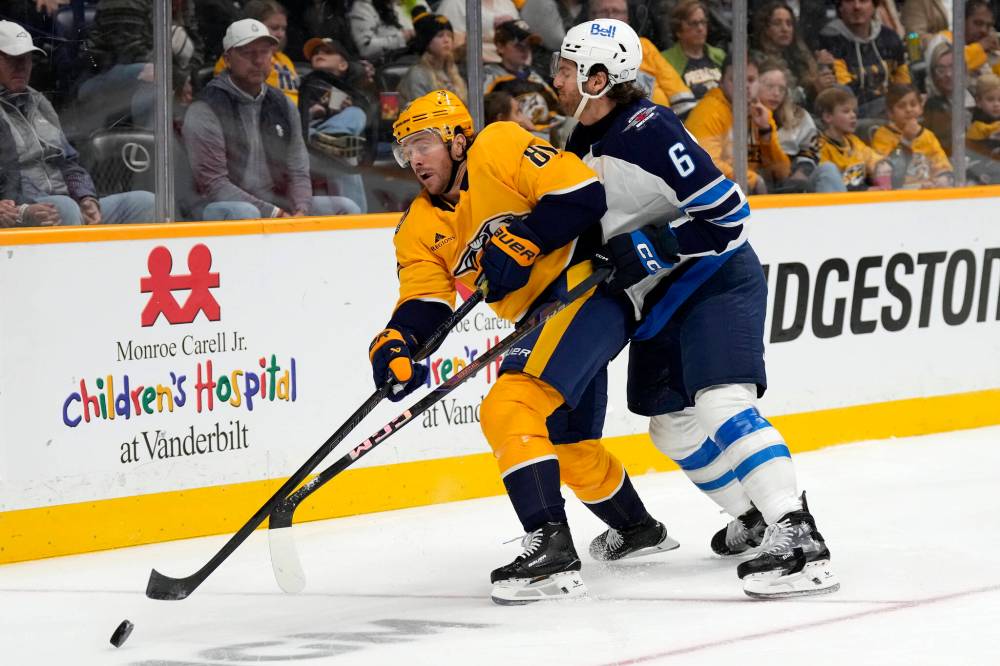
The nature of the injury makes it difficult to determine how long the runway will be or if there will be time on the sidelines required, even with Heinola having a clean bill of health. Logan Stanley remains injured, while Haydn Fleury has done a solid job in the 10 games he’s played.
However, the first-round pick of the Jets in 2019 has the zone-exit ability and offensive instincts to make an impact, provided he can stay healthy. Although the Jets’ power play units have done a nice job so far, it wouldn’t be surprising to see Heinola quarterback that second unit, with Neal Pionk moving over to the shooter position on the left-wing side — a job that’s currently being shared by Vladislav Namestnikov and Miller, depending on the situation.
If Heinola shows he can handle the defensive side of the game, the rest should take care of itself. It’s easy to forget that Heinola is still only 23 years old and his timeline has been skewed by him making the team out of camp in 2019 as an 18 year old and playing those five games before being assigned to the Moose and eventually returning to Finland. As far as becoming a permanent fixture, that’s a relative term.
Heinola has the skillset to be an NHL regular, but how impactful he’s going to be is up to him. He’s missed a lot of development time, but it’s not out of the realm of possibility that there will come a time somewhere down the road when Heinola could work his way up to a second pairing role that includes power-play time. Regular work on the third pairing is the first hurdle to clear though.
ken.wiebe@freepress.mb.ca
X: @WiebesWorld
mike.mcintyre@freepress.mb.ca
X: @mikemcintyrewpg

Raised in the booming metropolis of Altona, Man., Ken Wiebe grew up wanting to play in the NHL, but after realizing his hands were more adept at typing than scoring, he shifted his attention to cover his favourite sport as a writer.

Mike McIntyre grew up wanting to be a professional wrestler. But when that dream fizzled, he put all his brawn into becoming a professional writer.
Our newsroom depends on a growing audience of readers to power our journalism. If you are not a paid reader, please consider becoming a subscriber.
Our newsroom depends on its audience of readers to power our journalism. Thank you for your support.
History
Updated on Sunday, November 24, 2024 3:54 PM CST: Rearranges photos
Updated on Sunday, November 24, 2024 4:47 PM CST: Corrects typos










